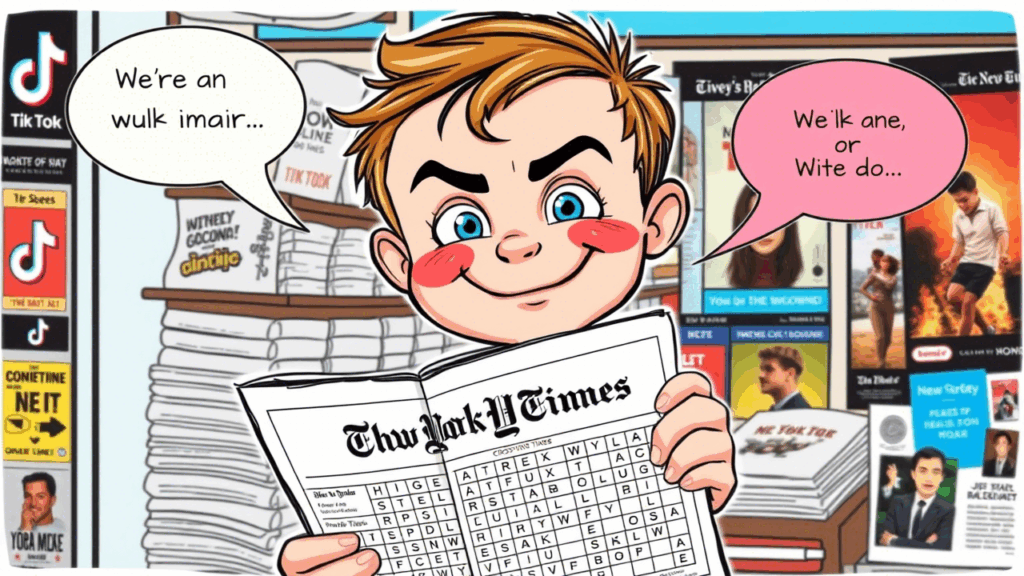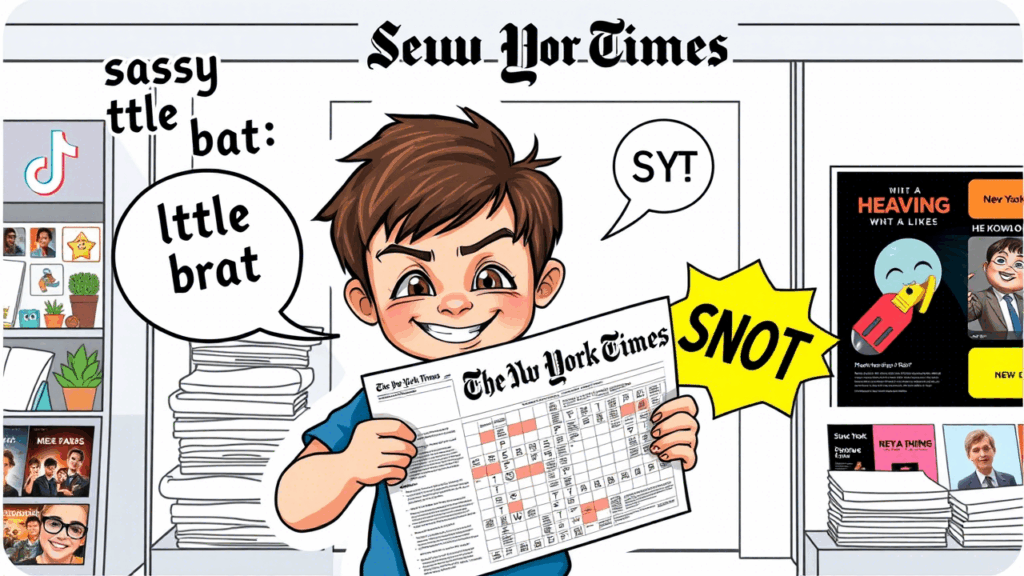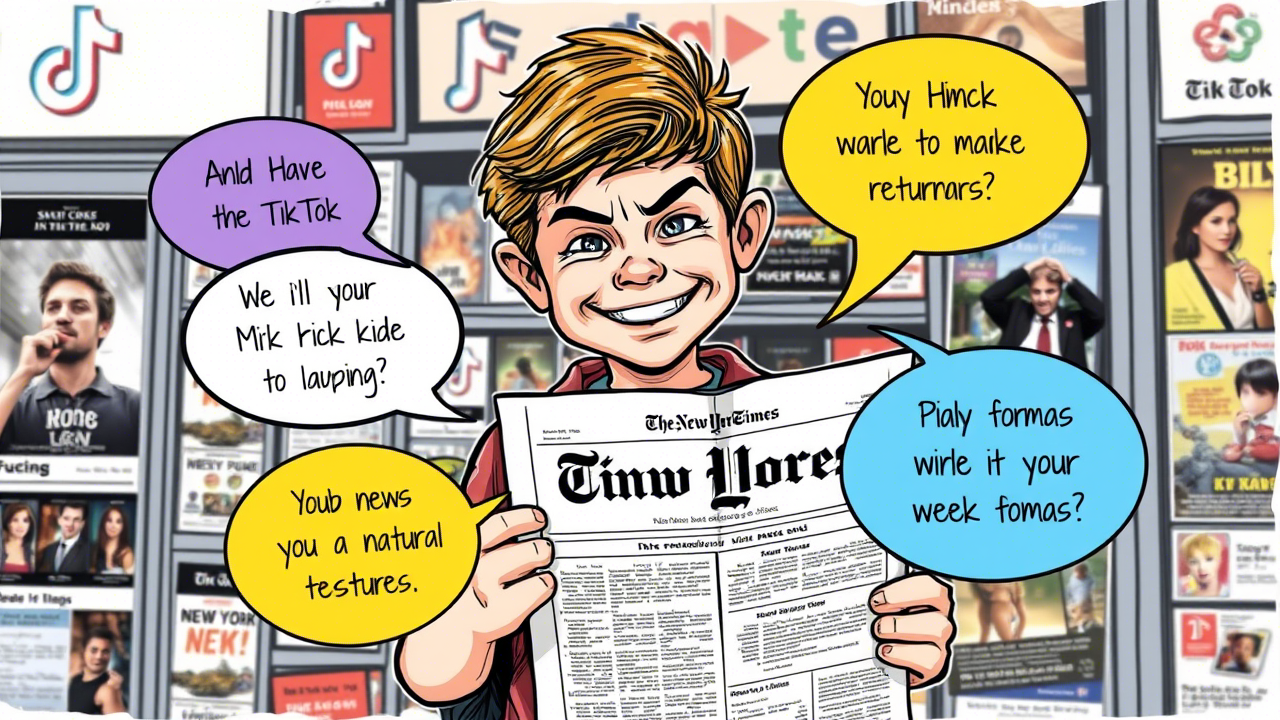The phrase sassy little brat NYT sparks curiosity. It’s bold, cheeky, and tied to the prestigious New York Times, making it a cultural lightning rod. Whether you stumbled across it in a crossword puzzle or a viral article, this term grabs attention and refuses to let go. So, what’s behind its charm? Why does it resonate with so many readers? Let’s dive into the layers of meaning, cultural impact, and playful rebellion that make sassy little brat NYT a phenomenon worth exploring.
The Phrase’s Playful Origins
Where did the sassy little brat NYT come from? The term “sassy little brat” paints a vivid picture of a mischievous, confident child who’s equal parts charming and frustrating. “Sassy” brings to mind quick wit and bold attitude, while “brat” suggests a touch of naughtiness. When paired with “NYT,” it takes on a new life, often linked to the New York Times’ knack for clever wordplay in crosswords or provocative commentary in articles. This combination feels fresh, relatable, and just a little rebellious, inviting readers to lean in and ponder its context.
Crossword enthusiasts know the thrill of cracking a tricky clue, and sassy little brat NYT delivers that rush. In June 2024, the New York Times Mini Crossword featured this clue, stumping solvers with its playful misdirection. The answer? “SNOT.” It’s a word that’s both crude and clever, perfectly capturing the cheeky essence of a “sassy little brat.” This moment cemented the phrase’s place in puzzle lore, sparking chatter across forums and social media.
A Cultural Touchstone
Why does the sassy little brat NYT feel so relevant? It taps into a broader cultural fascination with bold personalities. From TV shows to TikTok, characters who embody this archetype—think sharp-tongued kids or defiant teens—captivate audiences. The phrase reflects society’s love-hate relationship with rebellion. You admire the confidence but wince at the audacity. The New York Times amplifies this by weaving the term into discussions about parenting, pop culture, and even journalism’s evolving tone.
Consider how the media portrays these characters. In movies, the “sassy little brat” often steals the show with witty one-liners and fearless antics. The NYT has spotlighted this archetype in articles about child behavior, exploring how parents navigate raising confident yet respectful kids. The phrase encapsulates the tension between encouraging individuality and setting boundaries, a topic that resonates with readers navigating similar challenges.
The Crossword Connection
How does sassy little brat NYT shine in crosswords? The NYT’s puzzles are legendary for their cleverness; this clue is a prime example. Solvers initially grappled with words like “snob” or “imp,” but “SNOT” proved the perfect fit. It’s a four-letter word slang for an obnoxious kid and a nod to nasal mucus, adding a layer of humor. This wordplay showcases the NYT’s ability to blend wit with challenge, keeping solvers hooked.
The clue’s difficulty lies in its misdirection. You might picture a spoiled child, but the answer requires lateral thinking. Crossword fans shared their struggles online, with some admitting they felt triumphant after cracking it. This shared experience fosters community as readers bond over the puzzle’s quirks. The phrase’s appearance in the NYT Mini Crossword on June 20, 2024, made it a talking point, proving that even a slight clue can have a significant impact.
Parenting and Personality
What does the sassy little brat NYT reveal about parenting? The NYT often explores the challenges of raising bold children, and this phrase captures the essence of that struggle. Articles highlight the fine line between fostering confidence and curbing disrespect. A child labeled a “sassy little brat” might be admired for their spunk but criticized for crossing boundaries. This duality sparks lively debates among parents, educators, and readers.
Yet assertive behavior can sometimes tip into defiance, leaving adults unsure of how to respond. The NYT’s coverage of this topic feels timely as readers grapple with similar questions in their own lives. By using sassy little brat NYT in articles, the publication taps into a universal experience, making its content relatable and thought-provoking.

Pop Culture’s Embrace
How has sassy little brat NYT infiltrated pop culture? Beyond crosswords and articles, the phrase resonates in movies, TV, and social media. Characters like Pippi Longstocking or modern sitcom kids embody this spirit, blending charm with chaos. On platforms like TikTok, creators channel “sassy little brat” energy through witty videos and bold captions, celebrating confidence and humor. The NYT’s use of the term amplifies its cultural cachet, bridging traditional media with digital trends.
Celebrities also play a role. Stars known for their bold personas often embrace the “sassy little brat” label, using it to highlight their fearless authenticity. The NYT’s commentary on these figures connects the phrase to broader discussions about identity and self-expression. Readers are drawn to this narrative as it mirrors their desire to stand out while staying true to themselves.
Journalism’s Playful Shift
Why does the sassy little brat NYT reflect a change in journalism? The New York Times has long been a bastion of serious reporting but has shifted toward a more engaging, relatable tone in recent years. As some articles describe it, the “sassy little brat” persona captures this evolution. Headlines now feature cheeky wordplay, and stories blend insight with humor, appealing to younger audiences who crave authenticity.
This approach doesn’t sacrifice credibility. Instead, it makes complex topics more accessible. By embracing the sassy little brat NYT in its content, the NYT bridges the gap between traditional journalism and modern sensibilities. Readers appreciate this balance, as it invites them into the conversation rather than preaching. The result? A loyal audience that feels connected to the news in a new way.
Social Media Buzz
How does sassy little brat NYT thrive online? Social media platforms amplify the phrase’s reach, turning it into a meme-worthy soundbite. Twitter threads dissect its crossword origins, while Instagram posts celebrate its playful vibe. The term’s versatility—it can describe a cheeky kid, a bold celebrity, or even a witty article—makes it perfect for viral content. Readers share their own “sassy little brat” stories, creating a sense of community around the phrase.
The NYT’s savvy use of social media fuels this buzz. Snippets from articles featuring the sassy little brat NYT often go viral, sparking debates and laughter. This digital engagement keeps the phrase relevant as users remix it into memes and captions. The result is a cultural loop in which the NYT’s content inspires online creativity, which in turn drives more readers to its pages.
The Gender Angle
Does sassy little brat NYT carry gendered undertones? The phrase often evokes images of young girls, as “sassy” is frequently used to describe female assertiveness. NYT articles have explored this, questioning whether society judges bold girls more harshly than boys. The term can feel like a compliment and a critique, highlighting the complex expectations placed on women and girls. This nuance adds depth to the phrase, inviting readers to reflect on their biases.
By addressing these issues, the NYT positions itself as a thought leader. Readers engage with articles that challenge stereotypes, sparking discussions about gender and behavior. Sassy little brat NYT becomes more than a catchy phrase—it’s a lens through which to examine societal norms, making it a powerful tool for introspection.

Why It Sticks
What keeps the sassy little brat NYT in our minds? Its blend of humor, relatability, and provocation makes it unforgettable. Whether it’s a crossword clue that stumps you, an article that sparks debate, or a meme that makes you laugh, the phrase delivers an emotional punch. The NYT’s ability to weave it into diverse contexts—puzzles, parenting, pop culture—ensures its staying power.
Readers find themselves drawn to its energy. It’s a reminder that boldness can be endearing even when it’s a little naughty. The phrase encourages you to embrace your sass, to laugh at life’s chaos, and to engage with the world in a way that’s authentic and fearless. That’s the magic of sassy little brat NYT—it’s not just a phrase; it’s an invitation to live a little louder.
Final Thoughts
So, what’s the verdict on sassy little brat NYT? It’s a cultural gem that captures the spirit of our times. From crossword clues to parenting debates, it reflects our fascination with confidence, rebellion, and wit. The New York Times has harnessed its power to engage readers in a fresh, relevant, and fun way. Next time you encounter a sassy little brat in NYT, take a moment to savor its cheeky charm. It’s more than a phrase—it’s a conversation starter, a puzzle solver, and a mirror to our ever-evolving culture.









